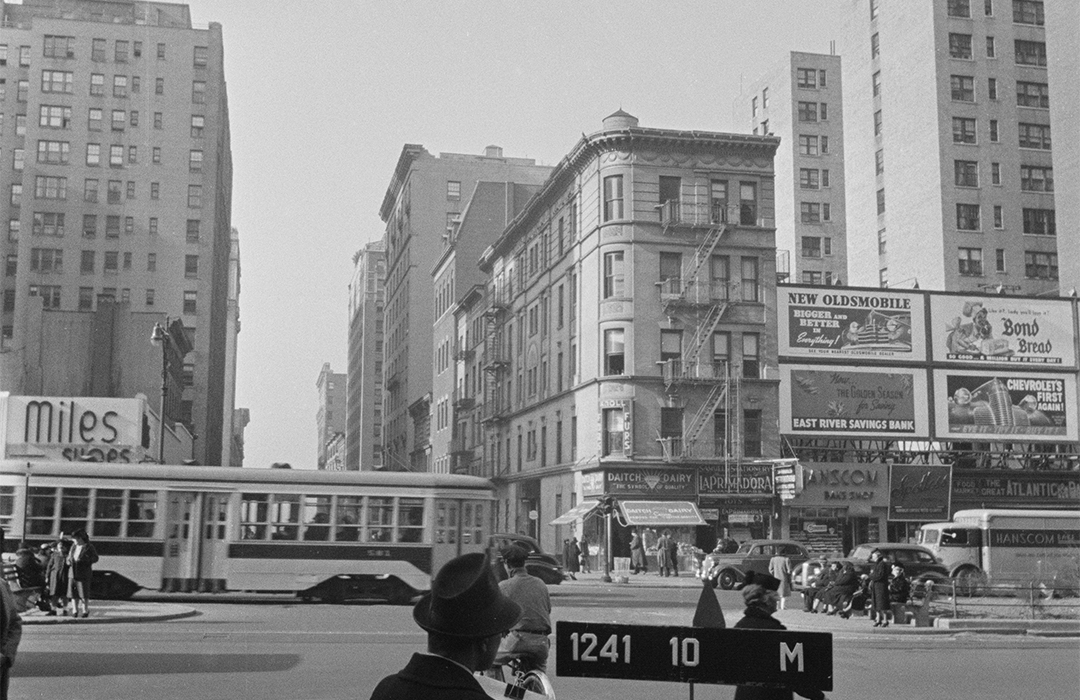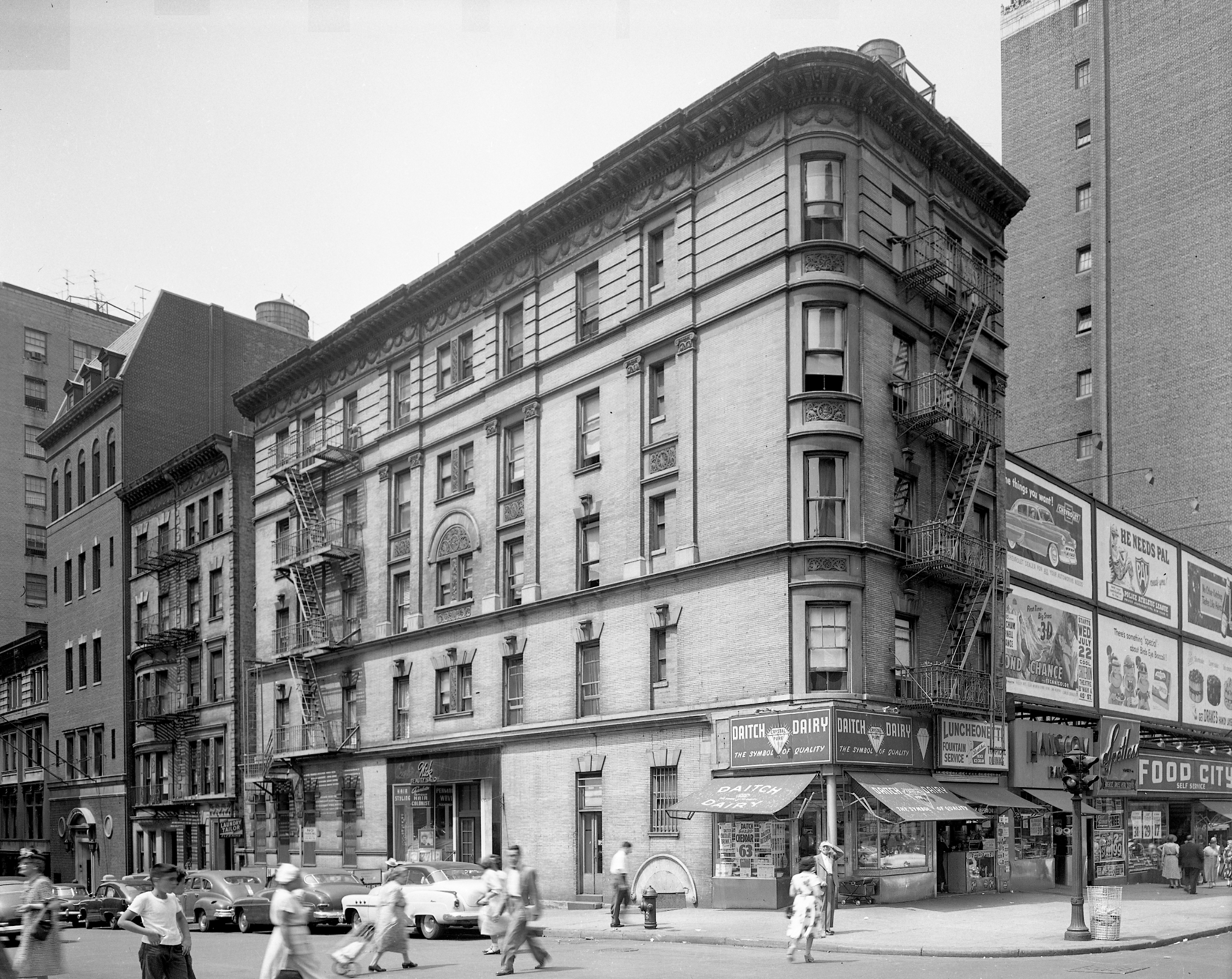
2501 Broadway
by Tom Miller
In February 1897, developer and builder Alexander Walker broke ground for a five-story “brick store and flat” at the northwest corner of the Boulevard (later Broadway) and 93rd Street. Designed by architect George F. Pelham, it would cost the equivalent of $1.2 million in 2023 to construct.
The completed structure was a mere 25-feet-wide on Broadway and stretched 95 feet along West 93rd where the residential entrance was located. Pelham’s Renaissance Revival design featured a rounded corner and decorative panel carved with Renaissance-inspired motifs. The spacious apartments each had seven rooms and a bath.
Among the initial residents was well-to-do bachelor Frederick W. Ludmann, described by The Chicago Tribune as “a young man of means.” He was a member of the printing firm Ludmann & Co. Around the time he moved in, he began seeing a wealthy heiress, Maud Hewitt, the daughter of sugar broker Francis Hewitt. The New York Herald said, “At one time Mr. Ludmann frequently called upon the young woman and was often seen in her company.” He would quickly regret ever having met her.
At some point, the pair stopped seeing one another, but it was apparently not an amicable break-up. In 1899 Ludmann became engaged to another woman, and the scorned Maud Hewitt began spreading vicious stories about him. On October 12, 1899, the New York Herald reported that she claimed, “that he did not pay his debts, was not honorable in his actions, and should not be allowed to live in a respectable hotel, and that he had been secretly married.” The ruthless accusations said the newspaper, “caused considerable anguish of mind to a young woman to whom he is now engaged.”
Maud stooped even lower. The New York Herald went on to say that she “circulated a report that he was a negro, solely because his hair is black and curly.” The newspaper was choosing its words diplomatically. The Chicago Tribune was more direct, reporting that at “divers time and in a variety of places,” Maud Hewitt called Ludmann “a nigger.”
According to his lawyer, William Wingate Hubbard, “since then he had been living at a rapid pace.”
It all came to a head in August 1899 when, simply by chance, Ludmann checked into the Long Beach Hotel—the same hotel where the Hewitt family was staying. Maud continued her malicious attacks on Ludmann there. They were heard by Van De Wattering, a “boxing master and golf expert,” according to the New York Herald. Wattering had words with the 30-year-old Ludmann, then struck him. “A fight ensued, and Mr. Ludmann was thrown to the beach,” said the article. “The affair caused great excitement at the hotel, and the patrons, taking sides, split into several factions.” The Chicago Tribune noted that Ludmann “was unmercifully pounded.” Back in Manhattan, Ludmann filed suit against the 25-year-old Maud Hewitt, seeking damages of $25,000 (a significant $845,000 today). His complaint said, among other things, that she was “instrumental in bringing about the thrashing.”
Living here at the time of the scandal were brothers Crosby and E. Leonard Fox. The wealthy young men were from Louisiana where their father had been a Supreme Court Justice. Crosby was affiliated with the Joplin Copper Mining Company, while his brother lived the carefree life of a gentleman. Upon the death of their grandfather, James Burbank, they inherited a large estate, E. Leonard’s portion amounting to about $2.25 million by today’s terms. According to his lawyer, William Wingate Hubbard, “since then he had been living at a rapid pace.”
In June 1899 Crosby Fox went West on business. His brother, more interested in nightlife than working, left home on the night of July 29 and ended up in the apartment shared by Sidney West (a female) and Lillie Lawrence on West 39th Street. It sat within an area known as “Soubrette Row,” taking its name from the French word for chambermaid. It was a play on words for the “chamber maids” that could be found there.
E. Leonard Fox would never return to his uptown apartment. Three days later an ambulance rushed him from the 39th Street apartment to Bellevue Hospital where he died of the effects of alcohol and opium. The three women in the flat, Sidney West, Daisy Andrew, and Lillie Lawrence, were arrested “as suspicious persons.”
At the hospital, Fox’s attorney, William Wingate Hubbard, noticed that there was no cash in Fox’s pockets. He told police that when the young man left his apartment he had had $350 in cash, and that his gold watch and chain, and several rings were also missing. The New York Press reported, “the detectives searched Lillie Lawrence’s flat. In a trunk in the bedroom they found Leonard’s coat and waistcoat, in the pockets of which were his watch and chain.”
According to Lillie, Leonard had asked her to place his valuables in a safe place. “They were presents from his mother, and he did not want to lose them,” she said. She told police that “she knew nothing about the rings, or how much money Leonard had when he went to her flat.”
T. Edward Ward and his wife went to the Garrick Theatre on March 12, 1905. When they arrived home, Mrs. Ward discovered that her brooch was missing. She notified the theater, which “was searched high and low,” according to The Sun, but the pin was not found. She placed an advertisement in the newspapers, offering a $1,000 reward for its return—a substantial $31,800 in today’s money.
In the meantime, the brooch had been found in a grating outside the theater by someone in far more reduced circumstances than the Wards. Known simply as Quigley and described by The Sun as “a tall, raw boned Irishman,” he had been living in a Salvation Army lodging house on the Bowery for six months where he paid 10 cents a night for a bed. He first assumed the gems were paste, but then remembered reading that a drop of water would cling to a diamond and roll off glass. He tried it. The drop of water stayed on the gems in the brooch.
Quigley and a friend scoured the papers looking for the owner. When he found Mrs. Ward’s advertisement, he went to the jeweler as directed and was given a $1,000 bill. After breaking it (for a $1 fee), he handed out $100 to friends on the Bowery, bought a suit of clothes and new shoes, and opened a bank account. Now, he told a reporter, “I’ve got money in the bank. What I want is a job.”
[Quigley] had been living in a Salvation Army lodging house on the Bowery for six months where he paid 10 cents a night for a bed.
Residents of 251 West 93rd Street had at least one servant. A help-wanted advertisement in The Sun in February 1920 read, “Houseworker—Neat, refined white girl for light general housework and assist with year old baby; no laundry work; city in winter, country in summer; good home; good wages.” At the time the residents were paying between $1,100 to $1,500 rent per year, or about $2,000 per month on the higher end today.
Owen Warren Davis II suffered a fatal heart attack at the age of 80 in his apartment here on October 8, 1920. His wife, Abigail (known as Abby) Augusta Gould, had died in 1914. A veteran of the Civil War, he had been in the iron business for decades, but, according to The New York Clipper, “five years ago established a photographic studio in West Forty-second street.” Among the four surviving of his five children was playwright Owen Gould Davis, who would write more than 200 plays and receive the 1923 Pulitzer Price for Drama for his play Icebound.
A one-year renovation by architect S. Walter Katz begun in 1938 resulted in four apartments per floor. Among the tenants in the early 1970s was Dr. Jaime Condori and his wife, Pepa. Dr. Condori was a resident in pathology on the staff of Metropolitan Hospital Center.
A horrific episode played out in the Condori apartment on the afternoon of Sunday, June 13, 1976. Pepa, who was 40 years old, accused her husband of having an affair. An argument followed, and at around 5:25 p.m., Pepa grabbed a carving knife. The New York Times reported that the 36-year-old physician received “stab wounds in the groin, shoulder and chest.” Pepa Condori’s rage was such that the blade of the knife snapped in half. With her husband dead on the floor, Pepa telephoned police. She was taken into custody and charged with homicide.
Although the ground floor of George F. Pelham’s 1898 building has been drastically altered, the upper floors are greatly intact, its prim façade disguising the often dramatic stories that played out inside.
Tom Miller is a social historian and blogger at daytoninmanhattan.blogspot.com
BUILDING DATABASE
Keep Exploring
Be a part of history!
Think Local First to support the businesses currently at 2501 Broadway aka 251 West 93rd Street:



